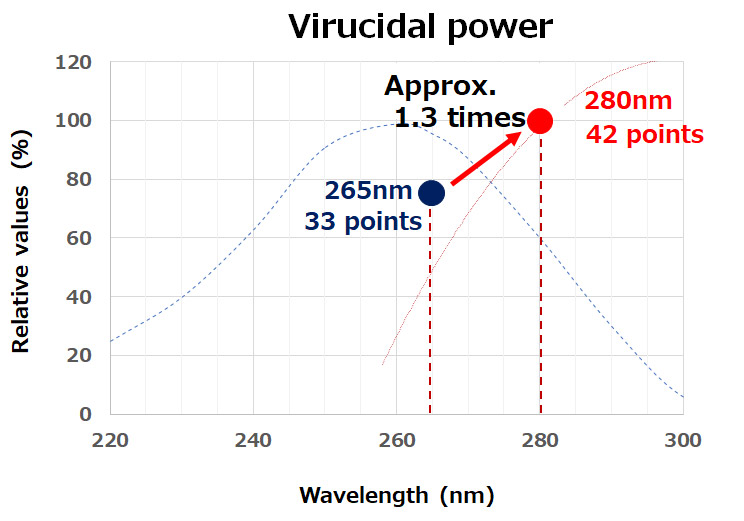News: LEDs
28 January 2021
Nichia’s new 280nm deep-UV LEDs eliminates up to 99.99% of SARS-CoV-2
Nichia Corp of Anan City, Tokushima, Japan has launched the NCSU334B deep-UV LED which, at a peak wavelength of 280nm, is claimed to outperform other commercially available UV-C LEDs (regardless of wavelength) in output, efficiency and lifetime. Meanwhile, independent research has confirmed that they are also best-in-class for disinfection performance against the SARS-CoV-2 novel coronavirus.
Nichia says that its UV-C LED technology was extensively tested at Tokushima University to demonstrate its bacteria and virus disinfection efficiencies. Experiments conducted by the Graduate School of Biomedical Sciences confirmed that irradiating SARS-CoV-2 with the NCSU334B for 30s at a fluence (UV dose) of 51mJ/cm2 yielded 99.99% inactivation (see Figure 1). The experiment was also conducted on the basis of the NCSU334B’s binned input power and for 1.7mJ/cm2 and 5cm distance. There remains adequate room to reduce the time or increase the dosage, depending on the conditions or the designated working distance, the number of LEDs or the input power. For example, at half the working distance, the performance increases fourfold.
Reflecting its commitment to serve global markets, Nichia has scaled up its investment in R&D and manufacturing capacity for its UV LED products. Now in mass production, the NCSU334B, at a wavelength of 280nm, achieves what is claimed to be industry-leading output, efficiency and lifetime. It delivers a typical irradiance of 70mW with a wall-plug efficiency (radiance efficiency) of 3.6% (an improvement of 27% on its predecessor). Due to its hermetic seal, it also provides long lifetime performance, especially at peak temperatures and humidity levels.
While traditional UV-C technologies, such as low-pressure mercury vapor lamps, were limited to a 254nm peak, the most efficient wavelength to disinfect bacteria and viruses is known to be 260nm due to the peak absorption spectrum of the DNA/RNA. However, Nichia has demonstrated that 280nm delivers the highest virucidal power as it has a very strong irradiance, wall-plug efficiency and lifetime, all at practical operating conditions versus what are described as many other unreasonable claims in the market. Indeed, data highlights that the virucidal power of the 280nm LED is about 1.3 times (127%) that of 265nm LEDs. The 280nm LED also delivers a lifetime ten times longer than a 265nm LED.

Generally, the advantageous compact size of LED-based UV-C solutions means that they can be directly integrated within disinfection applications in restricted spaces including industrial applications, water purifiers, air conditioning systems etc.
UV-C light is making a significant contribution to combatting viruses and bacteria, simplifying traditional methods. For example, to obtain a high viricidal effect (i.e. 4-log) when using an alcohol solution for disinfection (containing 77–81% ethanol), surfaces need to be sufficiently wetted with the substance or require significant effort and time (often times beyond 30s). Used in conjunction with such measures, Nichia’s 280nm deep UV LED can provide a highly viricidal effect while saving time and effort.
Nichia says that, after succeeding in 1997 in developing and mass-producing deep UV LEDs, it aims continuously to improve its products. So, after many years of accumulated research into the technology of crystal growth and package structures with efficient heat dissipation, the firm plans to announce further expansion of its UV-C portfolio soon.









